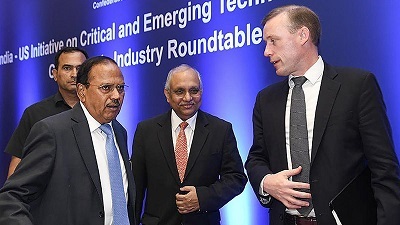Context-
Despite the seemingly successful talks between National Security Adviser Ajit Doval and his U.S. counterpart Jake Sullivan in June, structural challenges persist in the execution of the bilateral Initiative on Critical and Emerging Technologies (iCET). Local industry officials and military analysts highlight significant impediments primarily related to the autonomy of U.S. defense companies in transferring technology, which has been developed at immense cost. These companies zealously guard their intellectual property rights (IPR), and the U.S.'s strict export control laws, controlled by its defense industrial complex, are reluctant to share military technologies via joint ventures, even when such collaborations align with Washington’s broader strategic interests.
Current Focus of iCET
Presently, the iCET’s defense component is centered on local manufacturing of General Electric GE F-414INS6 after burning turbofan engines to power the under-development Tejas Mk-II light combat aircraft. Additionally, it includes locally assembling 31 armed MQ-9 Reaper/Predator-B unmanned aerial vehicles (UAVs) for all three services, at an estimated cost of around $3 billion.
Limitations in Technology Transfer
Negotiations have reportedly concluded for GE to transfer approximately 80% of the technology required for Hindustan Aeronautics Limited to produce the F-414 engines. However, critical know-how related to forging metallurgy discs for the turbines is excluded. For the MQ-9 UAVs, technology transfer from General Atomics Aeronautical Systems is around 10-15% and includes setting up a domestic maintenance, repair, and overhaul (MRO) facility. Additionally, negotiations are ongoing to acquire, license-build, and co-develop the General Dynamics Land Systems Stryker Infantry Combat Vehicle for the Indian Army under iCET patronage.
Challenges in Execution
Military analyst Abhijit Singh notes that the U.S. government does not act on behalf of its defense companies that own the IPRs for their technologies. U.S. defense vendors, driven by commercial interests and accountable to shareholders, are cautious about the extent of technology they are willing to transfer. These commercial considerations, coupled with bureaucratic challenges, contributed to the failure of the 2012 Defense Technology and Trade Initiative (DTTI) between India and the U.S., on whose framework the iCET was established in June 2023, with a more ambitious scope.
The Legacy of DTTI
The DTTI failed primarily due to issues related to technology transfer. The iCET, in contrast, is supported by various organizations, including INDUS-X (India-U.S. Defense Acceleration Ecosystem), Joint IMPACT (INDUS-X Mutual Promotion Advanced Collaborative Technologies) 1.0, IMPACT 2.0, and ADDD (Advanced Domains Defense Dialogue).
Exercising ‘Jugaad’
A strategy suggested by domestic defense industry officials to ensure the attainment of iCET’s goals involves allowing the Indian military to exercise the innovative ‘jugaad’ approach on its U.S. platforms. This method has historically enabled India’s military to render imported platforms serviceable in diverse climatic conditions and terrains, often exceeding their declared potential. For instance, the fleet of Chetak and Cheetah helicopters, originally French-origin Alouette III and SA-315B Lama, have been adapted to operate at heights over 14,000 feet in the Siachen glacier region, a capability not anticipated by the original manufacturers.
Enabling Protocols and Constraints
However, the complex set of enabling protocols that India has executed with the U.S. foreclose the possibility of pursuing the jugaad route for most recent acquisitions. These acquisitions, effected via the Foreign Military Sales (FMS) route, fall under the stricter ‘Golden Sentry’ end-use monitoring program, which completely disallows jugaad.
Strategic Implications
The iCET also aligns with the U.S.’s broader policy, as outlined in a recent Senate Foreign Relations Committee report, urging President Joseph Biden to address India’s close strategic ties with Moscow and its dependency on Russian arms. The February 2023 report implicitly suggests that India should begin sourcing its future military equipment from Washington, potentially via the iCET route.
Conclusion
The iCET must avoid the pitfalls outlined by Norman Augustine, an Under Secretary of the U.S. Army, in his aphorisms known as Augustine’s Laws. One such law humorously warns that the more time spent discussing actions, the less time is available to execute them, ultimately leading to a situation where all time is spent talking about nothing. The success of iCET hinges on overcoming these innate limitations, particularly the autonomy and commercial interests of U.S. defense companies in transferring critical technologies.
|
Probable Questions for UPSC Mains Exam-
|
Source- the Hindu







